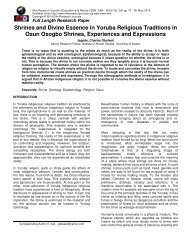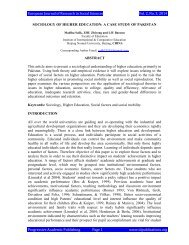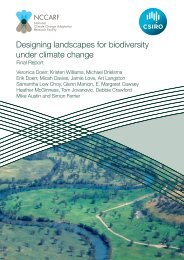Williams-Climate-change-refugia-for-terrestrial-biodiversity_0
Williams-Climate-change-refugia-for-terrestrial-biodiversity_0
Williams-Climate-change-refugia-for-terrestrial-biodiversity_0
You also want an ePaper? Increase the reach of your titles
YUMPU automatically turns print PDFs into web optimized ePapers that Google loves.
3.4.5 Distance measures<br />
At a given location, the climate may <strong>change</strong> dramatically, but if there is large spatial<br />
variation in climates in the vicinity of this location, a population can track its suitable<br />
climate by moving a short distance. On the other hand, if climate is largely<br />
homogenous <strong>for</strong> large distances around the point of interest, a population needs to<br />
move a long way to track its suitable climate. Thus, a useful measure of climate <strong>change</strong><br />
impact is the distance a population would have to move to remain within a suitable<br />
climate space. We estimated this metric <strong>for</strong> both annual mean temperature and annual<br />
mean precipitation. In the <strong>for</strong>mer case, we calculated the distance a population would<br />
have to move by 2085 to stay within 2 SDs of the annual mean temperature at that<br />
location. For annual mean precipitation, given the much smaller relative shifts in this<br />
metric, we used a more stringent criteria; having to stay within 1 SD of local annual<br />
mean precipitation. These measures were calculated <strong>for</strong> each of the 18 GCMs <strong>for</strong> four<br />
RCPs (APPENDIX 2. <strong>Climate</strong> Stability). The 10 th , 50 th and 90 th percentile across the 18<br />
GCMs <strong>for</strong> RCP 8.5 are detailed in Figure 12.<br />
The results <strong>for</strong> temperature were compelling, with small required movement distances<br />
surrounding areas of topographic relief (because lowland species can retreat upwards<br />
to these areas as temperature increases). Upland areas at the centre of this<br />
topographic relief, however, typically show very long required movement distances,<br />
because equivalent temperatures in these areas move off the top of mountains and, by<br />
2085 can only be found at far removed locations. This is true <strong>for</strong> parts of the Great<br />
Dividing Range such as the high elevation areas of the Australian Wet Tropics, the<br />
central Queensland coast uplands, and the New South Wales (NSW) and Victorian<br />
alpine areas. Also, the high elevation areas of the MacDonnell Ranges, Northern and<br />
Central Kimberley, the Pilbara, the Flinders Lofty Block and the Tasmanian Central<br />
Highlands. Interestingly, the low elevation areas of Arnhem Land, the Nullarbor and<br />
south-west Western Australia have no nearby analogous temperatures in 2085. For the<br />
Nullarbor and south-west Western Australia, this is likely to be a consequence of being<br />
situated at the southern edge of the landmass where there are no areas available to<br />
the south that would provide suitable temperatures into the future.<br />
Tellingly, some cells had no corresponding cell within 2 SDs of current temperature; <strong>for</strong><br />
these locations there is no place on the continent with equivalent temperatures<br />
in 2085 (APPENDIX 2. <strong>Climate</strong> Stability). In fact, over 9000 km 2 across the continent<br />
had no corresponding cell within 2 SDs of current predicted by at least one GCM. For<br />
993 km 2 , all 18 GCMs predicted that there would be no area with a similar temperature<br />
by 2085. The areas projected to have no corresponding temperature within 2 SDs are<br />
all high elevations of southern Australia (mostly Victoria and Tasmania). These areas<br />
are currently the coldest parts of Australia, and no area is predicted to be as cold by<br />
2085 (APPENDIX 2. <strong>Climate</strong> Stability). Many other cells required movements of greater<br />
than 500 km by 2085; distances that are likely impossible <strong>for</strong> many low vagility taxa.<br />
26 <strong>Climate</strong> <strong>change</strong> <strong>refugia</strong> <strong>for</strong> <strong>terrestrial</strong> <strong>biodiversity</strong>






